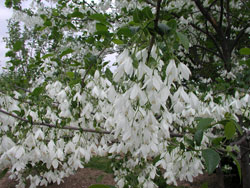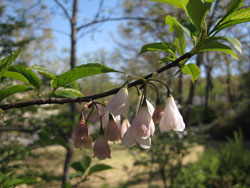Resource Library
Plant of the Week: Silverbell, Carolina
The University of Arkansas System Division of Agriculture does not promote, support or recommend plants featured in "Plant of the Week." Please consult your local Extension office for plants suitable for your region.
Plant of the Week
Carolina silverbell
Latin: Halesia tetraptera ssp monticola

The great eastern forests are home to many beautiful trees, and gardeners and nurserymen have sorted through them, chosen the ones they like best and grown them in great numbers.
The southern magnolia, dogwood and redbud have been selected, at least according to their usage in the landscape, as favorites. But there are many lesser-known plants that also deserve attention. Amongst those worthy of consideration is the Carolina silverbell, Halesia tetraptera.
Carolina silverbell is a deciduous understory tree of the small styrax family that consists of only six genera. In its typical form, Carolina silverbell grows as a low-branched, squatty tree 30 to 40 feet tall that may spread 25 to 30 feet across. In its subspecies monticola, known as the mountain silverbell, the tree tends to grow with a straight unbranched trunk and can reach heights of over 60 feet with a more elongate form. It also has somewhat larger leaves and flowers.
Silverbell has alternate, simple leaves 3 to 5 inches long. In the summer, leaves are a medium green that turn subtle shades of yellow before dropping in the fall.

The flowers of silverbell are white, bell-shaped blossoms one-half to three-quarters of an inch long and wide. The blooms appear in mid-to-late April and dangle down the slender branches like so many fancy earbobs. A pink form is also available.
The fruit, which is often produced in some abundance, is a four-winged, tan-colored dry drupe that reaches 1.5 inches long. Germination is notoriously difficult in this species, so don't anticipate any unwanted seedlings.
Carolina silverbell has a decidedly erratic distribution pattern. The center of distribution is in the southern Appalachian Mountains, but isolated stands are found in cool, moist valleys as far west as Oklahoma. Trees are usually found on north-facing, sloping ground where the soil is rich and well drained. They prefer an acidic site with a pH between 5.0 and 6.0. The mountain silverbell has a more isolated natural distribution, and is only found at higher elevations in cool mountain coves of the Appalachians.
From an ornamental standpoint, Halesia diptera, the two-winged silverbell, has the best flower performance of the group. A selection called variety magniflora is especially free flowering with blooms almost twice as large as H. tetraptera. It is a multi-trunked dogwood-sized tree growing to 20 feet tall, with flowers appearing about a week later than Carolina silverbell.
Silverbells, at least as landscape-sized plants, are somewhat difficult to establish, so container-grown specimens should be used. They make an excellent addition to the woodland garden, where they are dependable bloomers in moderate shade. Give them a good soil and water during periods of extreme drought. They are hardy in zones 4 to 8.
By: Gerald Klingaman, retired
Extension Horticulturist - Ornamentals
Extension News - May 14, 2010
The University of Arkansas System Division of Agriculture does not maintain lists of retail outlets where these plants can be purchased. Please check your local nursery or other retail outlets to ask about the availability of these plants for your growing area.